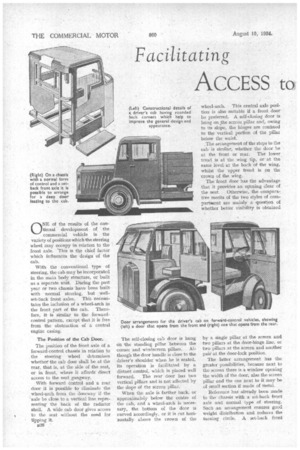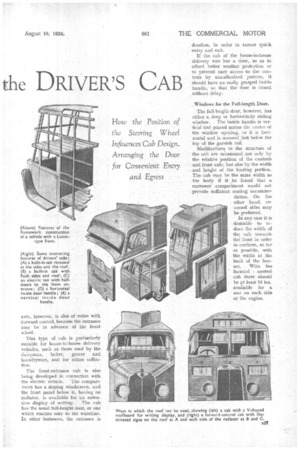Facilitating
Page 36

Page 37

If you've noticed an error in this article please click here to report it so we can fix it.
ACCESS to the DRIVER'S CAB ONE of the results of the continual development of the commercial vehicle is the variety of positions which the steering wheel may occupy in relation to the front axle. This is the chief factor which influences the design of the cab.
With the conventional type of steering, the cab may be incorporated in the main body structure, or built as a separate unit. During the past year or two chassis have been built with normal steering, but wellset-back front axles. This necessitates the inclusion of a wheel-arch in the front part of the cab. Therefore, it is similar to the forwardcontrol pattern, except that it is free from the obstruction of a central engine casing.
The Position of the Cab Door.
The position of the front axle of a forward-control chassis in relation to the steering wheel determines whether' the cab door shall be at the rear, that is, at the side of the seat, or in front, where it affords direct access to the seat gangway.
With forward control and a rear door it is possible to eliminate the • wheel-arch from the doorway if the ' axle be close to a vertical line representing the back of the radiator shell. A wide cab door gives access to the seat without the need for Upping it.
B2G The self-closing cab door is hung on the standing pillar between the corner and windscreen pillars. Although the door handle is close to the driver's shoulder when he is seated, its operation is facilitated by a distant control, which is placed well forward. The rear door has two vertical pillars and is not affected by the slope of the screen pillar.
When the axle is farther back, or approximately below the centre of the cab, and a wheel-arch is necessary, the bottom of the door is curved accordingly, or it is cut horizontally above the crown of the
wheel-arch. This central axle position is also suitable if a front door be preferred. A self-closing door is hung on the screen pillar and, owing to its slope, the hinges are confined to the vertical portion of the pillat below the waist.
The arrangement of the steps to the cab is similar, whether the door be at the front or rear. The lower tread is at the wing tip, or at the same level at the back of the wing, whilst the upper tread is on the crown of the wing.
The front door has the advantage that it provides an opening clear of the seat. Otherwise, the comparative merits of the two styles of cornpartutent are mainly a question of whether better visibility is obtained
by a single pillar at the screen and two pillars at the door-hinge line, or two pillars at the screen and another pair at the door-lock position.
The latter arrangement has the greater possibilities, because next to the screen there is a window opening the width of the door, also the screen pillar and the one next to it may be of small section if made of metal.
Reference has already been made to the chassis with a set-back front axle and normal type of steering. Such an arrangement ensures good weight distribution and reduces the turning circle. A set-back front axle, however, is also of value with forward control, because the entrance may be in advance of the front wheel.
This type of cab is partiQularly suitable for house-to-house delivery vehicles, such as those used by the dairyman, baker, grocer and laundryman, and for refuse collection.
The front-entrance cab is also being developed in connection with the electric vehicle. The compartment has a sloping windscreen, and the front panel below it, having no radiator, is available for an exten sive display of writing. The cab has the usual full-height door, or one which reaches only to the waistline. In other instances, the entrance is doorless, in order to ensure quick entry and exit.
If the cab of the house-to-house delivery van has a door, so as to afford better weather protection or to prevent easy access to tile controls by unauthorized persons, it should have an easily grasped inside handle, so that the door is closed without delay.
Windows for the Full-length Door.
The full-length door, however, has either a drop or horizontally sliding window. •The inside handle is vertical and placed across the centre of the window opening, or it is horizontal and is screwed just below the top of the garnish rail.
Modifications in the structure of the cab are occasioned not only by the relative position of the controls and front axle, but also by the width and height of the loading portion. The cab may be the same width as the body if it be found that a narrower compartment would not provide sufficient seating accommo dation. On the other hand, re cessed sides may be preferred.
In any case it is desirable to reduce the width of the cab towards the front in order to conform, so far as possible, with the width at the back of the bonnet. With the ' forward control cab there should be at least 16 ins. available for a seat on each side of the engine.




















































































